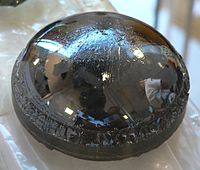
Photo from wikipedia
Abstract The static and dynamical phase stabilities of refractory nitrides based on plane wave calculation in the framework of generalised gradient approximation (GGA) are reported in this work. The calculation… Click to show full abstract
Abstract The static and dynamical phase stabilities of refractory nitrides based on plane wave calculation in the framework of generalised gradient approximation (GGA) are reported in this work. The calculation reveals that the postulated zinc blende (B3) phase is statically and dynamically stable unlike the cesium chloride (B2) because of an appearance of imaginary modes in the phonon spectra which prevents the formation of this crystal phase similar to the corresponding carbides. The soft modes of the phonon bands were explored over a temperature range of 280–350 K. The indirect phase transition pressures from the zinc blende to the cesium chloride structure are about 10-, 8-, and 7-fold lower compared with the direct transformation from the ground state rock-salt structure to the B2 phase of TiN, ZrN and HfN respectively. The calculated electronic partial density of states show strong hybridization at the gap region and that all the crystal phases are metallic. Again, the phonon calculation showed an appearance of phonon gap for the rock salt and the zinc blende phases but collapsed in the B2.
Journal Title: Computational Materials Science
Year Published: 2017
Link to full text (if available)
Share on Social Media: Sign Up to like & get
recommendations!